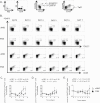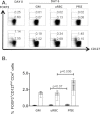Freeze-thaw lysates of Plasmodium falciparum-infected red blood cells induce differentiation of functionally competent regulatory T cells from memory T cells
- PMID: 22585585
- PMCID: PMC3549566
- DOI: 10.1002/eji.201142164
Freeze-thaw lysates of Plasmodium falciparum-infected red blood cells induce differentiation of functionally competent regulatory T cells from memory T cells
Abstract
In addition to naturally occurring regulatory T (nTreg) cells derived from the thymus, functionally competent Treg cells can be induced in vitro from peripheral blood lymphocytes in response to TCR stimulation with cytokine costimulation. Using these artificial stimulation conditions, both naïve as well as memory CD4(+) T cells can be converted into induced Treg (iTreg) cells, but the cellular origin of such iTreg cells in vivo or in response to more physiologic stimulation with pathogen-derived antigens is less clear. Here, we demonstrate that a freeze/thaw lysate of Plasmodium falciparum schizont extract (PfSE) can induce functionally competent Treg cells from peripheral lymphocytes in a time- and dose-dependent manner without the addition of exogenous costimulatory factors. The PfSE-mediated induction of Treg cells required the presence of nTreg cells in the starting culture. Further experiments mixing either memory or naïve T cells with antigen presenting cells and CFSE-labeled Treg cells identified CD4(+) CD45RO(+) CD25(-) memory T cells rather than Treg cells as the primary source of PfSE-induced Treg cells. Taken together, these data suggest that in the presence of nTreg cells, PfSE induces memory T cells to convert into iTreg cells that subsequently expand alongside PfSE-induced effector T cells.
© 2012 WILEY-VCH Verlag GmbH & Co. KGaA, Weinheim.
Figures






Similar articles
-
Modulation of the immune and inflammatory responses by Plasmodium falciparum schizont extracts: role of myeloid dendritic cells in effector and regulatory functions of CD4+ lymphocytes.Infect Immun. 2013 May;81(5):1842-51. doi: 10.1128/IAI.01226-12. Epub 2013 Mar 18. Infect Immun. 2013. PMID: 23509139 Free PMC article.
-
Plasmodium falciparum-mediated induction of human CD25Foxp3 CD4 T cells is independent of direct TCR stimulation and requires IL-2, IL-10 and TGFbeta.PLoS Pathog. 2009 Aug;5(8):e1000543. doi: 10.1371/journal.ppat.1000543. Epub 2009 Aug 14. PLoS Pathog. 2009. PMID: 19680449 Free PMC article.
-
Innate immune response to malaria: rapid induction of IFN-gamma from human NK cells by live Plasmodium falciparum-infected erythrocytes.J Immunol. 2002 Sep 15;169(6):2956-63. doi: 10.4049/jimmunol.169.6.2956. J Immunol. 2002. PMID: 12218109
-
Selected problems of malaria blood stage immunity.Tokai J Exp Clin Med. 1998 Apr;23(2):55-62. Tokai J Exp Clin Med. 1998. PMID: 10021776 Review.
-
Revisiting regulatory T cells in type 1 diabetes.Curr Opin Endocrinol Diabetes Obes. 2012 Aug;19(4):271-8. doi: 10.1097/MED.0b013e328355a2d5. Curr Opin Endocrinol Diabetes Obes. 2012. PMID: 22732485 Review.
Cited by
-
Decline of FoxP3+ Regulatory CD4 T Cells in Peripheral Blood of Children Heavily Exposed to Malaria.PLoS Pathog. 2015 Jul 16;11(7):e1005041. doi: 10.1371/journal.ppat.1005041. eCollection 2015 Jul. PLoS Pathog. 2015. PMID: 26182204 Free PMC article.
-
Plasmodium falciparum induces Foxp3hi CD4 T cells independent of surface PfEMP1 expression via small soluble parasite components.Front Microbiol. 2014 May 1;5:200. doi: 10.3389/fmicb.2014.00200. eCollection 2014. Front Microbiol. 2014. PMID: 24822053 Free PMC article.
-
IDO1-AhR axis increases T regulatory cells in Plasmodium vivax malaria infection.Front Immunol. 2025 Jul 14;16:1474447. doi: 10.3389/fimmu.2025.1474447. eCollection 2025. Front Immunol. 2025. PMID: 40726977 Free PMC article.
-
Characterization of T cell activation and regulation in children with asymptomatic Plasmodium falciparum infection.Malar J. 2018 Jul 13;17(1):263. doi: 10.1186/s12936-018-2410-6. Malar J. 2018. PMID: 30005684 Free PMC article.
-
Modulation of the immune and inflammatory responses by Plasmodium falciparum schizont extracts: role of myeloid dendritic cells in effector and regulatory functions of CD4+ lymphocytes.Infect Immun. 2013 May;81(5):1842-51. doi: 10.1128/IAI.01226-12. Epub 2013 Mar 18. Infect Immun. 2013. PMID: 23509139 Free PMC article.
References
-
- Sakaguchi S. Naturally arising Foxp3-expressing CD25+CD4+ regulatory T cells in immunological tolerance to self and non-self. Nat. Immunol. 2005;6:345–352. - PubMed
-
- Mills KHG. Regulatory T cells: friend or foe in immunity to infection? Nat. Rev. Immunol. 2004;4:841–855. - PubMed
-
- Belkaid Y, Blank RB, Suffia I. Natural regulatory T cells and parasites: a common quest for host homeostasis. Immunol. Rev. 2006;212:287–300. - PubMed
-
- Bluestone JA, Abbas AK. Natural versus adaptive regulatory T cells. Nat. Rev. Immunol. 2003;3:253–257. - PubMed
Publication types
MeSH terms
Grants and funding
LinkOut - more resources
Full Text Sources
Research Materials

